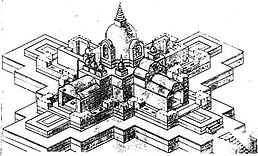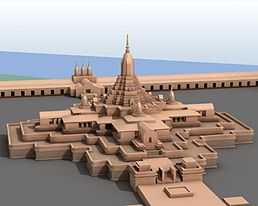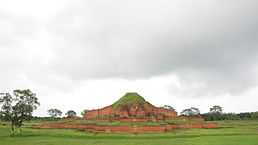Somapura Mahavihara
| Paharpur vihar | |
|---|---|
|
Native name Bengali: পাহারপুর বিহার | |
 View of the central shrine | |
| Location | Naogaon, Bangladesh |
| Coordinates | 25°01′52″N 88°58′38″E / 25.031095°N 88.977284°E |
| Elevation | 80 feet (24 m) |
| Built | 4th century AD |
| Built for | Dharama Pala |
| Architectural style(s) | Gupta, Pala |
| Type | Cultural |
| Criteria | i, ii, iv |
| Designated | 1985 (9th session) |
| Reference No. | 322 |
| State Party |
|
| Region | Asia-Pacific |
 Paharpur vihara is in Naogaon, Bangladesh
| |
Somapura Mahavihara (Bengali: সোমপুর মহাবিহার Shompur Môhabihar) in Paharpur, Badalgachhi Upazila, Naogaon District, Bangladesh (25°1'51.83"N, 88°58'37.15"E) is among the best known Buddhist viharas in the Indian Subcontinent and is one of the most important archeological sites in the country. It was designated a UNESCO World Heritage Site in 1985.
History




A number of monasteries grew up during the Pāla period in ancient Bengal and Magadha. According to Tibetan sources, five great Mahaviharas stood out: Vikramashila, the premier university of the era; Nalanda, past its prime but still illustrious; Somapura Mahavihara; Odantapurā; and Jaggadala.[1] The monasteries formed a network; "all of them were under state supervision" and there existed "a system of co-ordination among them ... it seems from the evidence that the different seats of Buddhist learning that functioned in eastern India under the Pāla were regarded together as forming a network, an interlinked group of institutions," and it was common for great scholars to move easily from position to position among them.[2]
The excavation at Paharpur, and the finding of seals bearing the inscription Shri-Somapure-Shri-Dharmapaladeva-Mahavihariyarya-bhiksu-sangghasya, has identified the Somapura Mahavihara as built by the second Pala king Dharmapala (circa 781–821) of Pāla Dynasty.[3] Tibetan sources, including Tibetan translations of Dharmakayavidhi and Madhyamaka Ratnapradipa, Taranatha's history and Pag-Sam-Jon-Zang, mention that Dharmapala's successor Devapala (circa 810–850) built it after his conquest of Varendra.[3] The Paharpur pillar inscription bears the mention of 5th regnal year of Devapala's successor Mahendrapala (circa 850–854) along with the name of Bhiksu Ajayagarbha.[3] Taranatha's Pag Sam Jon Zang records that the monastery was repaired during the reign of Mahipala (circa 995–1043 AD).[3]
The Nalanda inscription of Vipulashrimitra records that the monastery was destroyed by fire, which also killed Vipulashrimitra's ancestor Karunashrimitra, during a conquest by the Vanga army in the 11th century, assumed to be an army of the Varman rulers.[3] About a century later Vipulashrimitra renovated the vihara and added a temple of Tara.[3]
Over time Atish's spiritual preceptor, Ratnakara Shanti, served as a sthavira of the vihara, Mahapanditacharya Bodhibhadra served as a resident monk, and other scholars spent part of their lives at the monastery, including Kalamahapada, Viryendra and Karunashrimitra.[3] Many Tibetan monks visited the Somapura between the 9th and 12th centuries.[3]
During the rule of the Sena dynasty, known as Karnatadeshatagata Brahmaksatriya, in the second half of the 12th century the vihara started to decline for the last time.[3] One scholar writes, "The ruins of the temple and monasteries at Pāhāpur do not bear any evident marks of large-scale destruction. The downfall of the establishment, by desertion or destruction, must have been sometime in the midst of the widespread unrest and displacement of population consequent on the Muslim invasion."[4]
Architecture

The quadrangular structure consists of 177 cells and a traditional Buddhist stupa in the center. The rooms were used by the monks for accommodation and meditation. In addition to the large number of stupas and shrines of various sizes and shapes, terracotta plaques, stone sculptures, inscriptions, coins, ceramics etc. have been discovered.
The site houses the architectural remains of a vast Buddhist monastery, Somapura Mahavihara, covering 27 acres (110,000 m2). It was an important intellectual centre for Dharmic Traditions such as Buddhists (Buddha Dharma), Jains (Jaina Dharma) and Hindus (Sanatana Dharma) alike.[5] The 21 acre (85,000 m²) complex has 177 cells, viharas, numerous stupas, temples and a number of other ancillary buildings.[6] The outside walls with ornamental terracotta palques still display the influence of these three religions.
In acreage, Somapura was the largest of the mahaviharas.[7] It was also quite unusual architecturally. As one scholar described, the complex was dominated by a temple, which was not typical, and further, the temple had "none of the characteristic features of Indian temple architecture, but is strongly reminiscent of Buddhist temples of Burma, Java and Cambodia, reproducing the cruciform basement, terraced structure with inset chambers and gradually dwindling pyramid form ... during the age of the Palas some sort of intercourse between eastern India and south-east Asia existed ... but how this temple type, represented in India by this solitary example, became the standard of Buddhist temple architecture is not known."[8] Another commented, "there can be no doubt that this style of architecture has most profoundly influenced that of Burma, Java and Cambodia. The nearest approximation to the plan and the superstructure of the Paharpur temple is afforded by the temples known as Chandi Loro Jongrang and Chandi Sevu of Prambanam in Central Java."[8]
Central temple


The purpose of this central structure at the midst of the courtyard remains unsolved since its discovery. Hence, most of the debates generated hitherto on the architecture of Sompur Mahavihara are cantered on the identification its missing superstructure. The reason may be manifold, but the most important one is the non-availability of substantial amount of first-hand resource including a comprehensive architectural documentation at the disposal of the researchers. There are different arguments regarding the terminating top of the central structure of Sompur Mahavihara.
Consequently, most of works done so far are mainly based on the findings of the archaeological excavation and studying the artefacts from the archaeological perspective. The first study on this monument with documentation was by archaeologist K.N. Dikhist in his Paharpur, Memoirs of Archaeological Survey in India (1938). Dikhsit was concerned with documentation of the archaeological findings and concentrated on their interpretation and analysis. He attempted to suggest a probable architectural treatment of the missing parts of the structure through studying the archaeological remains. Till today, this study is considered as the most authentic record of the Sompur Mahavihara.
Prudence R. Myer published the first of such studies in 1969 as a journal paper, in which he proposed the missing superstructure as a stupa and illustrated the possible three-dimensional articulations.[9] Myer embarked on his proposal through a diachronic study of the stupa and stupa shrines in India. He took Sompur Mahavihara as an example to elaborate his study and did a conjectural restoration of the central structure in support of his analysis.
The second work was published around thirty years after Myer's proposition. A team of architects[note 1] from Khulna University lead by Mohammed Ali Naqi has proposed another theoretical reconstruction of the central structure as well as some parts of the peripheral block (mainly the entrance hall) in 1999. This work was also presented in the "International Seminar on Elaboration of an Archaeological Research Strategy for Paharpur World Heritage Site and Its Environment" jointly organized by UNESCO and Department of Archaeology of Bangladesh in 2004. Muhammad Ali Naqi proposed a temple-like spire at the top by considering the central mound as a ‘Stupa-Shrine’ with a ‘Shikhara’ type stupa in his reconstruction.[10]
Nameable statues found
The statues are reserved in the adjacent museum for display. Some nameable statues are:
- 'Chamunda' Statue of Clay Stone.
- Standing 'Seetala' Statue of Red Stone.
- Broken Parts of 'Visnu' Statue of Krishna Stone.
- 'Keerti' Statue of Clay Stone.
- Damaged 'Haargouri' Statue.
- Broken Statue of Laxmi Narayan of Krishna Stone.
- 'Uma' Statue of krishna Stone.
- 'Gouri' Statue of Clay Stone.
- 'Visnu' Statue of Clay Stone.
- Nandi Statue.
- 'Visnu' Statue of Krishna Stone.
- Sun Statue.
- 'Mansha' Statue of Clay Stone.
Protection

Somapura was designated a UNESCO World Heritage Site in 1985. Since then, a series of UNESCO missions has regularly visited the site and helped with the project. Moreover, the UN body prepared a master plan, involving US$5.6 million.[11][12][13]
The terracotta artworks in the site have suffered from serious damage as a result of "lack of proper maintenance, shortage of manpower, fund constraint and heavy rainfall."[14] Furthermore, poor water drainage accompanied by high levels of salinity in the soils has contributed to decay the terracotta sculptures.[15] Other threats include uncontrolled vegetation, vandalism, climate conditions, and public trespassing and encroachment.
Travel
Sompur Bihar at Paharpur is about 282 km by road from Dhaka. Iit will take about 6.5 hours to reach Paharpur by bus/taxi/private car if no major stops are made along the way. If one starts from Dhaka, the route shall be Dhaka - Savar - Chandra - Tangail - Jamuna Bridge - Bogura - Joypurhat - Paharpur. The best way to tour the site is to first reach Naogaon and stay there or reach Badalgacchi and stay there in Dakbanglo.
Notes
- ↑ Team members were Md Ali Naqi, Ziaul Islam, Md. Shoeb Bhuiyan and Catherine Daisy Gomes
See also
| Wikimedia Commons has media related to Somapura Mahavihara. |
- Ancient Universities of India
- Nalanda
- List of colossal sculpture in situ
More monuments in Bangladesh
- Bikrampur Vihara
- Kantajew Temple
- Shona Mosque
- Bagha Mosque
- Shahbaz Khan Mosque
- Noyabaad Mosque
- Khan Mohammad Mridha Mosque
- Sixty Dome Mosque
- Saat Masjid
- Lalbagh Fort
References
- ↑ Vajrayogini: Her Visualization, Rituals, and Forms by Elizabeth English. Wisdom Publications. ISBN 0-86171-329-X pg 15
- ↑ Buddhist Monks And Monasteries Of India: Their History And Contribution To Indian Culture. by Dutt, Sukumar. George Allen and Unwin Ltd, London 1962. pg 352–3
- ↑ 3.0 3.1 3.2 3.3 3.4 3.5 3.6 3.7 3.8 Somapura Mahavihara, Banglapedia: The National Encyclopedia of Bangladesh, Asiatic Society of Bangladesh, Dhaka, Retrieved: 2007-08-25
- ↑ Buddhist Monks And Monasteries Of India: Their History And Contribution To Indian Culture. by Dutt, Sukumar. George Allen and Unwin Ltd, London 1962. pg 376
- ↑ Singh, Sheo Kumar (1982). History and Philosophy of Buddhism. Delhi: Associated Book Agency. p. 44.
- ↑ A. K. M. Masud Alam, Shucheng Xie, Dilip Kumar Saha, Sifatul Quader Chowdhury, Clay mineralogy of archaeological soil: an approach to paleoclimatic and environmental reconstruction of the archaeological sites of the Paharpur area, 2007, Springer Berlin/Heidelberg
- ↑ Buddhist Monks And Monasteries Of India: Their History And Contribution To Indian Culture. George Allen and Unwin Ltd, London 1962. pg 375
- ↑ 8.0 8.1 Buddhist Monks And Monasteries Of India: Their History And Contribution To Indian Culture. by Dutt, Sukumar. George Allen and Unwin Ltd, London 1962. pg 373
- ↑ Myer, Prudence R. (1961), "Stupas and Stupa-Shrines", Artibus Asiae 24 (1): 25–34, retrieved 17 April 2012
- ↑ Naqi, Md. Ali; Islam, Ziaul; Bhuyan, Md. Shoeb; Gomes, Catherine Daisy (1999), "The virtual reconstruction of Paharpur vihara", Khulna University Studies 1 (1): 187–204
- ↑ Ruins of the Buddhist Vihara at Paharpur, UNESCO.
- ↑ UNESCO Dhaka
- ↑ Article on Somapura Mahavihara, from Encyclopædia Britannica.
- ↑ Hasibur Rahman Bilu (April 25, 2009). "World Heritage Site Left in Ruins". The Daily Star.
- ↑ Hasibur Rahman Bilu (December 15, 2007). "Salinity and Neglect Ruin Paharpur Terracotta". The Daily Star.
External links
- Banglapedia Article on Somapura Mahavihara
- Pharapur Buddhist Vihara from Department of Archeology, Government of Bangladesh
- More info,images, videos, 360degree panoramic views and more
| ||||||||
Template:UNESCO World Heritage Sites in Bangladesh
| |||||
| ||||||||||||||||||||||||||||||||||||||||||||||||||||||||
Coordinates: 25°01′52″N 88°58′37″E / 25.03102°N 88.97706°E